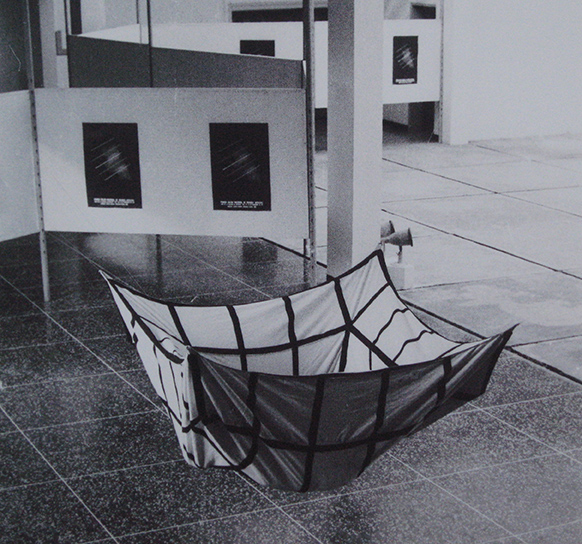Eugenio Espinoza
PAMM. Miami

Eugenio Espinoza: Unruly Supports (1970-1980) constitutes a rigorous exhibition that embarks the viewer on an exploration of Eugenio Espinoza’s (San Juan de los Morros, 1950) radical proposal. Featured at the PAMM and curated by Jesús Fuenmayor, the exhibition, composed of over fifty works that include paintings, photographs, sculptures, postcards and documentations of performances and interventions, underscores the work developed by the artist during the 1970s, when Espinoza’s proposal became an unequivocal turning۔point within the tradition of modern Venezuelan art, more specifically, its abstract and kinetic trends.
Making use of the Renaissance grid as principle of order and structure, Espinoza gives up color, resorting solely to the utilization of black paint on raw canvas, cut and wavy, which he incorporates in installations and performances with deep conceptual roots. Liberated from its support, the canvas becomes a malleable emotional structure that reacts, at the local level, in the oppressive presence of Venezuelan kinetic art, and in terms of art history, of the strict tradition of concrete art acting as map and canon.
Cuadrilátero, Sin título (Circunstancial) [Quadrangle, Untitled (Circumstantial)] and Sin título (Funcional) [Untitled (Functional)] , presented for the first time at the National Young Artists Salon , Casa de la Cultura, Maracay, 1971, and included in this show, evidence this interest.
Untitled (Circunstancial) [Untitled (Circumstantial)] , is a square canvas in which the grid is inscribed. Suspended from the ceiling by its four corners, the canvas becomes deformed by the weight of 12 hidden coconuts that alter the rigidity of the canvas, while incorporating at the same time a tropical background, the expression of the artist’s concern with reconciling the concrete European tradition and Venezuelan identity.
Impenetrable, 1972, exhibited for the first time at the Ateneo in Caracas, marks a crucial point within Eugenio Espinoza’s career and Venezuelan art history itself. The work, composed of a canvas on a stretcher frame, adopts the dimensions and the shape of the gallery’s perimeter. On it rests Espinoza’s iconic grid, rendered in black. Far from becoming the structure that organizes access to the show, the grid۔painting becomes an obstacle, blocking the passage of visitors who are stopped at the threshold by a grid that becomes their opponent. The title of the work ( Impenetrable) parodies the then popular Penetrables by Jesús Soto, and Espinoza thus extends his criticism to the abstract۔geometric and kinetic traditions that dominated the art of the country in the 1950s and 1960s, setting itself up as a sort of new academy.
A year later, the instrumental use of the grid would lead the artist to a mandatory inquiry into the Italian Renaissance. The series Florencia (Florence), 1973, appropriates icons from Western art history, specifically from Florentine art – Florence being the cradle of the Renaissance. In this way, the Palazzo Vecchio, featuring a “Christo۔style” intervention, wears the swirly grid like a mantle, while Michelangelo’s David holds in his right hand, instead of a stone, the grid۔canvas as a sort of self۔portrait – artist’s statement.
Similar interventions but referred to the local context (landscapes and iconic figures of Venezuelan identity), may also be appreciated in the show.
Unruly Supports … also includes a selection of photographs from the historical performance Sin Titulo (Untitled), 1973, in which the grid, liberated from the gallery, is returned to its natural space and spontaneously manipulated by the public, generating an experience۔based symbiosis with the Venezuelan landscape and the Venezuelan individual. In connection with this work, Unruly Supports… presents in the museum park the interactive installation on view for one day only Off the Grid, in which Espinoza’s signature grid, spread out like a great blanket in the public space, invites the viewer to experience its possibilities.
Unruly Support … also has the merit of presenting several works that had been included in the artist’s iconic exhibition 20 obras recientes (20 Recent Works), featured at the Museum of Fine Arts in Caracas in 1972, and which had not been exhibited again until the present show.
As an epilogue, the exhibition comprises works dating from Espinoza’s sojourn in New York, when the grid opens up, the canvas disappears and the line, reminiscent of ivy, covers the wall directly.
With accuracy and precision, Eugenio Espinoza: Unruly Supports (1970-1980) manages to get to the bottom of the proposal of this enfant terrible of Latin American art, in which geometric tradition, arte povera and minimalism articulate into an extremely personal proposal that functions as an alternative to the developmental trends of the Venezuela of the 1960s and 1970s, while it suggests at the same time new ways of inquiring into and integrating the abstract۔constructive tradition in the context of Latin American and universal art.




